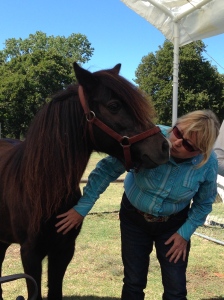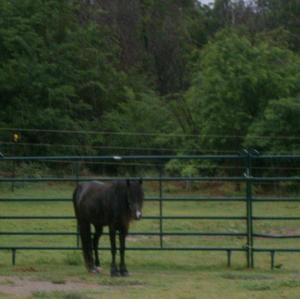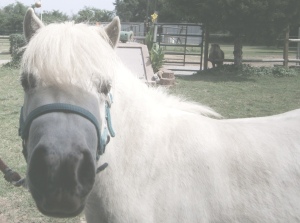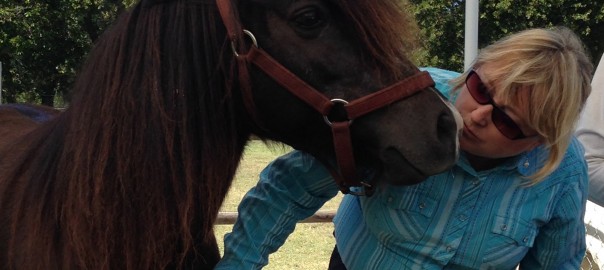For a number of years now, I’ve been doing distance bodywork on horses and people. Honestly, it doesn’t matter how far away those horses are, they can still greatly benefit from this help both anatomically and physiologically.

Distance bodywork or distance healing communication, in this case Equine Ortho-Bionomy (which is not only for distance but is a hands-on, structural non-force modality), is not like animal communication. It involves healing from a distance. The “communication” is only the beginning of the session – usually when the owner contacts me, and when I make contact with the animal.
In this one case, my friend and colleague Ruella Yates was worried about her Welsh pony mare, Starwyn and her mini mare, Jackie. Starwyn had a long history of foundering as a result of a very abusive situation which also involved very poor nutrition before Ruella had gotten her. Jackie, at four years old, had just begun to show signs of founder with pain in her feet.

At this point at the end of May when Ruella contacted me, both trimmer and vet were not positive about the prognosis for Starwyn. Jackie’s resistant behavior was as a result of pain; this should have been apparent to any professional working with her.
I’d seen Starwyn in October of 2013, at which time, she offered to be a big part of the Liberty Foundations Clinic co-taught by Ruella and myself at her Spirit Horse Ranch. By April, she was moving very little. I did a treatment on her then, but was concerned that she was moving so much less than she was back when I visited before. This time she was not participating in the clinic much at all.

Now in May of this year, Starwyn was hardly moving and lying down a lot. Then surprisingly, the same thing began to happen with Jackie. These horses were at the time in the dry lot without grass. They receive only herbs and grass hay for forage. When I saw the photos of Starwyn’s feet I was shocked. They looked a lot worse than I remembered. Starwyn was wearing boots almost all the time and standing in the hay trough to have a soft place to stand.
Ruella and I had tried a number of herbal remedies with some success, including white willow bark for pain rather than bute, but now the two girls were doing worse after the trimmer’s last visit. Jackie had behaved really “badly,” as she had been in tremendous pain and couldn’t tolerate anyone touching her hooves at that time.
The horses had been receiving white willow bark rather than bute as well as an herbal hoof oil. But after the last trim, the vet said since they were in such pain, to give them bute and banamine the day of the trim, plus sedate them. Then they were to take the bute/banamine for 4 days after.
Then, although her trimmer had thought Starwyn would have to be put down soon and the vet had said he was just hoping to make both horses “comfortable,” I had the strong feeling from Starwyn that she wanted help and she wasn’t ready to check out yet. I’ve worked with Starwyn on and off for about three years now and so we knew each other. I had the distinct sense of holding Starwyn in an imaginary sling.
So I called Ruella the next morning. When we talked, she said she’d had the same image of the sling.
Jackie was lying down groaning, and Starwyn was hardly able to stand either. I said I don’t know what I can do, but when can you work with me and do a session on the two girls? Ruella went out right then with her house phone clamped to her nightgown to leave her hands free, and began to work. Ruella had worked with me this way with horses before.
I had checked in with both horses and worked with Starwyn first since she had contacted me. We worked with the shoulder and hips, spine and cranial areas, opening up circulation through the spine and limbs. I told Ruella where to put her hands and what to do with them in each place. In some places I moved my energy in to shift things while she was somewhere else. When Starwyn had had enough she sighed deeply and walked away.
When we went to Jackie she was lying in the barn, groaning. She was in such pain and I got an immediate sense that she was having an allergic reaction to the bute. She was also highly reactive which I attributed to her anger at the situation. I felt that I shouldn’t get too close to her legs. So I cleared that anger for her. I told Ruella we were stopping the bute right now, and we’d keep her on the natural pain reliever. We worked on her in much the same way as Starwyn but with emphasis on her abdominal pain, facial points, cranium, ears, and neck.
Within hours, Ruella called to tell me both girls were up and eating. They were markedly better, not lying down as much. I suggested a new complement of herbs for them including the white willow bark, and they were doing well with that. They were no longer on any drugs.

I told Ruella, you must get a second opinion. At that point she was very hesitant; not knowing anyone who might be able to offer that. I said, there has to be someone else, and I pointed her to The Horses Hoof website, where trimmers in all states in good standing are listed. There is still no guarantee, going to that site, that you’ll find a good one, but it’s a place to start. I said, if the first one doesn’t work out, pick another one, and keep doing so until you find someone.
She picked one who said he could come in three weeks. At that point we didn’t know whether the girls would relapse after the treatment or be able to continue in relative good health. Yet the girls continued to improve and hold their own, being able to walk once again.
When the new trimmer saw the feet, he was shocked at what bad condition they were in, and was amazed at how the girls had survived. He was amazed also, at the fact that we had kept them going with Equine Ortho-Bionomy treatments and herbs for the period of time until he arrived.
After he worked on the feet, the girls began to walk much easier, and to explore their new range of movement. Starwyn no longer needs to wear boots. Jackie has no digestive pain and is walking better as well.
We continued the use of the herbs which seem to be working for the girls overall.
To me, this heartening story shows me that 1) horses can be healed from a distance, and 2) you need to take every aspect of your horse’s care into your own hands, and 3) the bodywork that I do is designed to help the system self-correct even when everything in the body isn’t perfect. It engages the self-corrective mechanism so healing can be happening in spite of the improperly trimmed feet, digestive imbalance, etc.
This isn’t the first time I have had a case where the veterinarian, the chiropractor, the acupuncturist, the nutritionist, you name it – have all said the owner should be prepared to have to put the horse down. I have come on the scene, not having a clue what I might do for the horse, and the horse responds, knows what he wants from me, and improves so greatly everyone is surprised. The reason they are surprised is because they follow popular belief, and in some cases, years of experience, and begin to leave out room for possibility.
Throughout my career as a horse professional and even when I was simply a horse lover, people would crow “the vet said, or “my farrier said,” or “my trimmer is certified in this method…” We are at a crossroads today between traditional veterinary and farrier care and alternative care for both the entire organism and the hoof. Many people are afraid to try alternative care for their horses until they have no other resources, just as many people choose allopathic medicine and only seek a homeopathic or bodywork alternative when they have run out of options. Why not put alternative care closer to the top of the list? It is a valuable resource that can complement rather than hinder veterinary care. Education is really the key here.
The reason I embarked on studying Ortho-Bionomy was because it healed and supported so many conditions. I have helped myself and many others avoid surgeries, recover from joint stiffness, heal from acute and chronic conditions, emotional problems and maintain conditions that will not see an easy outcome.
What was evident with Jackie and Starwyn, was the bodywork elevated their health to the level they could manage until a good therapeutic trim could be done.
Once the mares were able to walk comfortably, Ruella began walking them daily as much as possible. As she works at liberty, she didn’t use a halter and lead rope, as after the new trimmer trimmed the horses were willing and happy to move at a trot as well as walk. Her gelding helped by herding them, knowing that the girls needed to walk.
Here is Starwyn walking just this past week.
[youtube https://www.youtube.com/watch?v=qqcD6RUsHMs&w=560&h=315]The proof of the pudding is in how the horse’s care is being implemented, and is that professional taking into consideration the horse holistically? That banamine and bute are so routinely prescribed by vets for everything from a bellyache to founder to a soft tissue injury, demonstrates that there is still a lot of research to be done in the area of pain management.
In the case of hoof care, just because a trimmer has good credentials doesn’t mean they are the best trimmer for your horses. The best bet, if you know nothing about feet, is to learn about them. Then go out and look at hooves and determine which ones look good to you.
Since I do bodywork on a lot of local horses, I look at a lot of feet. I can now almost tell who has trimmed what horse by his or her trimming style. I also know what I like and don’t like.
Is what I do animal communication? In a sense, yes. If I didn’t listen to the horse, receive pictures from the horse, and experience the horse’s presence in my being,I probably wouldn’t be successful at this. But coupled with knowledge of the body, and how the body might heal itself, this represents a powerful and very effective combination that far surpasses what we think of as animal communication.
In summary, I believe it’s important that we take charge of our own personal, veterinary and trimming care by becoming more knowledgeable and surrounding ourselves with people who have access to real possibilities in health care. This way, you and your practitioners stay “in the flow” of providing the best you can for your horses, and in turn, for yourself.

****
(copyright: Susan Smith, OrthoHorse)
Services: Bodywork (Ortho-Bionomy for people, Equine Ortho-Bionomy): private sessions, tutorials, phone consultations, distance healing communication and gift certificates
Some Don’t Like it Hot – These Liberty Coaching clinics will take place in the cooler morning hours over the summer. If you want to host a clinic in your area, contact me to make arrangements. Prices will vary according to location and travel. susansmith@orthohorse.info 505-501-2478
Liberty Coaching: clinics, mini-clinics, workshops, private and semi-private sessions, tutorials, consultations: by appointment: 505.501.2478 or emailing susansmith@orthohorse.info Scheduling now. Contact me for details.
Starting July 22: First Horses at Liberty Foundations Online course. In this class, comprised of four calls complete with lessons, you will learn the fundamentals of how to work with a horse at liberty, inspired by herd behavior. The way that horses interact with each other maintains cooperative relationships, safety and survival. No restraints are used – the horse becomes a willing participant. Contact me if interested. Cost $300. The class runs through September 3. I conducted a free Liberty Coaching Call on March 12. If you did not have a chance to listen, here is the link: http://www.susith.com/orthohorse/freehorseatlibcall.mp3
Trail Riding Class in Cerrillos. Learn how to apply some Liberty Foundations to your trail riding experience for a safer, more connected ride, what I call the “centaur relationship” with your horse. The class will involve some ground, dimensional and saddle work, and a short trail ride. This clinic will fill up fast so let me know if you want to participate.
Combining cumulative knowledge from over 18 years of endurance riding, Liberty Horsemanship and Ortho-Bionomy bodywork practice, Susan Smith brings a unique perspective to getting a horse and rider ready for the trail – in mind, body and spirit.
September 27-28 – Spirit Horse Ranch Two-Day Liberty Foundations Clinic, Oklahoma City, Oklahoma – Engaging the Hearts and Minds of Horses. Susan Smith and Ruella Yates, co-teaching. Contact me or Ruella at 405-771-4274 (ruella@libertyfoundations.com)
December 13-14 – Horses at Liberty Weekend Clinic, DeLand, Florida – Bring your Horse into Deep Working Connection with Liberty Horsemanship. Instructor: Susan Smith. Contact Anne Daimler tdaimler@cfl.rr.com (386-822-4564) Susan at susansmith@orthohorse.info (505-983-2128 or cell 505-501-2478) 9:00-4:30 p.m.
Susan is a member of the Independent Liberty Trainers Network. libertytrainersnetwork.com/




Thank you for writing the account of healing for my mares Starwyn and Jackie, and doing this important work. I know you saved their lives, teamed up with other professionals. This was a defining experience in horse care, certainly. Thank you over and over again.
Ruella Yates
Spirit Horse Ranch
Liberty Foundations